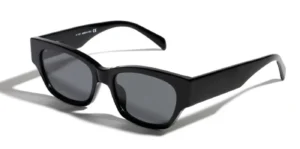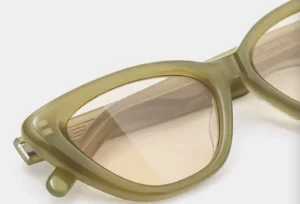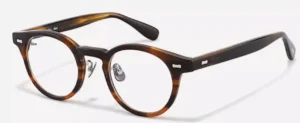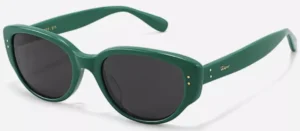The best quality lenses and frames are two important details of a pair of glasses. When it comes to lenses, there are different types to choose from, making it a question of how to discern the quality of lenses. So, how can we check the quality of lenses? The following 12 points about lens knowledge are of great reference value for selecting lenses for eyeglasses.
Now let’s learn how custom sunglasses manufacturers check the quality of lenses. Of course, if you are an ordinary consumer, it would also be helpful to you.

1. Check Lens Base Material Quality
The quality of the lens base material determines the durability of the lenses and the reliability of the coatings. A good base material is clear, transparent, long-lasting, and resistant to yellowing. On the other hand, some lenses may turn yellow or experience coating peeling after a short period of use. High-quality lenses should be free from scratches, blemishes, matte surfaces, or spots. When observing the lenses at an angle against a light source, they should exhibit a high level of smoothness. There should be no blemishes, deposits, streaks, bubbles, or cracks within the lenses, and they should allow bright and clear light transmission.
When selecting glasses, it’s important to consider the best lenses for glasses, as they can greatly impact your visual experience.
1.1 Check of Lens Appearance:
Check for lens color, tint kinks, spots, scratches, and other surface issues. Place the lens on a clean, white paper and carefully examine it under a QC light (a light source that is stronger and more uniform than regular daylight) for the aforementioned problems.
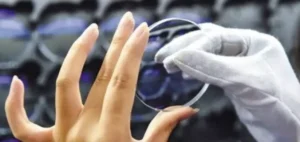
The best lenses for glasses will provide clear and crisp vision without distortion or blurriness.
1.2 Check of Lens Specifications:
The main tools for this inspection include a vernier caliper, thickness gauge, and curvature gauge. Use the vernier caliper to measure the lens diameter, the thickness gauge to measure the lens thickness, and the curvature gauge to measure the actual curvature of the lens.
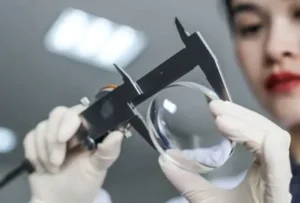
Look optic progressives (key search terms) high index progressive lenses. It’s worth investing in the best lenses for glasses, as they can improve your visual comfort and reduce eye strain.
2. Quality level of Lenses
Mass-produced lenses are classified into different quality grades based on their inherent quality differences, and there can be a significant price difference between higher-level and lower-level lenses.
3. Differences between Lens Brands
Differences in brands result in variations in quality and prices. The quality of lenses is directly reflected in the brand. Well-known brands typically offer lenses of good and consistent quality. Internationally recognized brands such as Essilor and Zeiss are widely known for their quality.

4. Testing Lens Transparency and Optical Uniformity
Hold the lens about 30 centimeters in front of your eyes and look at distant objects through the lens. If the objects appear clear and undistorted, and there is no jumping or shifting when you move the lens slowly, it means the lens is transparent and evenly made.
5. Testing Optical Center Displacement of Lenses
Draw a large cross on white paper and use one eye to look at the cross lines through the lens. Move the lens until the lines seen through the lens match the lines outside the lens. Mark small dots at the centers of the crosses on both lenses and check if the centers are symmetrical. Measure the distance between the dots and compare it to the recommended pupil distance. If the cross lines appear curved inside the lens, it may indicate internal stress or uneven density.
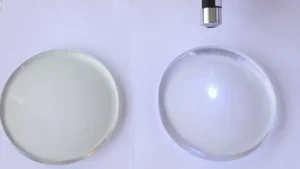
6. Determining the Axis of Astigmatism Lenses
Rotate the lens on the cross pattern at a distance of 30 centimeters and align the lines seen inside the lens with the lines outside, forming a perfect cross. Then, move the lens along the straight lines and observe which line deviates more from the straight line outside the lens. This line represents the axis of astigmatism. Mark the position on the lens where the lines align, and use a protractor to measure the angle between the axis and the horizontal line at the center of the lens, which represents the axis power.
7. Testing Lens Scratch Resistance
To test the scratch resistance of a lens, take a piece of rough paper, cloth, or other materials and rub it back and forth on the surface of the lens with a certain amount of force a specific number of times. Then, observe the results. High-quality lenses typically demonstrate good resistance to scratching, meaning they will show fewer scratches or signs of wear after the friction test.

High-quality lenses are the best lenses for glasses, offering superior durability and resistance to scratches and damage.
8. Testing Lens Adhesion
There are different methods to test how well a lens sticks to its surface. Two commonly used methods are the grid test and the knife test. In the grid test, a small blade is used to create tiny squares on the lens surface. Transparent tape is then applied firmly over the squares and peeled off repeatedly several times. The results are observed to see how well the tape sticks to the lens and assess the adhesion quality.
9. Testing Lens Impact Resistance
Also known as the ball drop test, it is used to assess the impact resistance of lenses. A ball drop testing machine is utilized to conduct this test. The lens is placed under the machine, and a ball of a specified weight is dropped onto the lens from a predetermined height. The results of the test indicate the lens’s ability to withstand impact and resist damage.
10. Testing Lens Functions
To test the functions of lenses, it is necessary to identify the specific functionalities of the lens and conduct corresponding tests. Common functionalities include oil resistance, water resistance, durability, UV400 protection, polarization, and others.
10.1 Lens Oil Resistance Test:
Use an oily pen to draw a line on the lens surface. If the oil quickly forms a spot that can be easily wiped off with a gentle swipe, it means the lens has oil resistance. Observe the degree of oil pooling and how effectively it can be cleaned to assess its oil resistance.
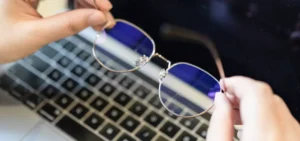
10.2 Lens Water Resistance Test:
Submerge the lens in clean water and gently shake it. If the water quickly drips off the lens surface, it indicates that the lens has water resistance. Assess the extent of water droplet shedding to evaluate its water resistance.
10.3 Lens Durability Test:
Under proper lighting, check if there is a clear adhesive layer on the lens surface and around its edges. Gently scratch the surface with a blade to assess its strength and flexibility.
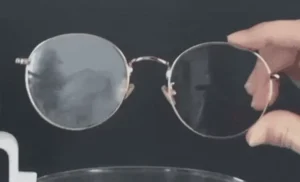
10.4 Lens Polarization Test:
Use a polarization tester or perform the following test: Open a Word document on a computer and hold the lens in front of it. Rotate the lens clockwise while observing the screen. The lens color will change from light to dark and eventually become completely black. Further rotation will result in a gradual lightening of the color.
This indicates the presence of a polarized lens. Pay attention to the color uniformity and whether it becomes sufficiently dark in the absence of light to determine the quality of the polarization function. Another simple way to test lens polarization is to vertically stack two polarized lenses. If no light passes through, it confirms the presence of polarized lenses.
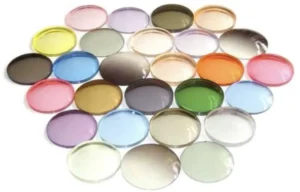
10.5 Lens UV400 Function Test:
UV400 means the lens blocks 100% of ultraviolet (UV) rays. To determine if a lens has UV400 protection, use a UV counterfeit money detector and a banknote like a 100 Chinese yuan bill. Shine the UV light on the banknote; if the UV security features are visible, it means the lens does not have UV400 protection. However, if the UV security features are not visible when viewed through the lens with UV400 functionality, it indicates that the lens blocks UV rays. The same method can be applied to U.S. dollar bills.
11. No discomfort when wearing glasses
When wearing glasses, there should be no dizziness, eye strain, or discomfort. The vision should remain clear, and objects should not appear blurry or distorted. During the purchase process, you can hold the glasses in your hand, look through one lens with a single eye, and focus on a distant object. Then, move the glasses up and down and side to side. The distant object should not appear to shift or move incorrectly.
12. Summary of How to Check the Quality of Eyeglass Lenses
The methods mentioned above provide some ways to inspect and test the quality of eyeglass lenses. However, it’s important to note that there is no absolute standard for lens quality. The requirements for lenses can vary among individuals and brands. Some may prioritize aesthetics, while others may focus more on functionality. Therefore, the emphasis during the inspection may also differ.
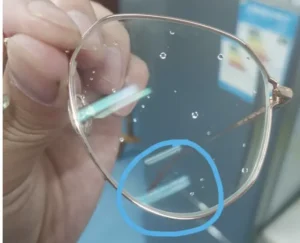
The best lenses for glasses may vary depending on your visual requirements, such as the need for progressive lenses or lenses with anti-reflective coatings.
It is crucial to remember that selecting a reputable optical store or sunglasses manufacturers when purchasing glasses is essential. They often provide lenses of more reliable quality.
